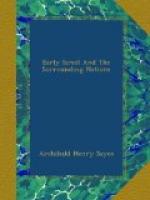The language of Ammon, if we may argue from the proper names, was, like that of Moab, a mere dialectal variety of that of Israel. The “language of Canaan” must have been adopted by the Ammonites and Moabites just as it was by the Israelitish tribes. The Moabite Stone has proved this conclusively. Moabite and Ammonite, Phoenician and Hebrew, were all alike dialects of one language, which differed from one another merely as one English dialect differs from another. Hebrew had retained a few “Arabisms,” a few traces of its ancient contact with Arabic-speaking tribes; that was all. In other respects it was the same as “the language of Canaan” on either side of the Jordan.
The Ammonites believed themselves to be the children of the national god Ammi. But Ammi was usually worshipped under the title of Malcham or Milcom, “the King.” It was to Milcom that Solomon erected an altar at Jerusalem, in honour of that Ammonite wife whose son Rehoboam succeeded him on the throne, and it was from the head of his image at Kabbah that his crown of gold and precious stones, 131 pounds in weight, was removed to grace the triumph of David.[8]
Moab was more exposed to the inroads of its nomadic neighbours from the wilderness than its sister-kingdom of Ammon. It lay along the eastern shores of the Dead Sea, and was a land of lofty mountains and fertile river-plains. Its wadis were coveted by the tribes of the desert; the well-watered valley of the Arnon attracted more powerful foes. When the Israelites encamped in “the plain of Moab,” Balak, the Moabite king, sent in terror to Balaam, the seer of Pethor. He had indeed cause for alarm. The Amorites had already robbed him of the fairest portion of his dominions; Moab north of the Arnon had fallen into their hands. The Amorite song of triumph has been preserved in the Book of Numbers. “Come unto Heshbon,” it said; “let the city of Sihon be built and fortified. For a fire has gone forth from Heshbon, a flame from the city of Sihon; it hath consumed Ar of Moab, and the Baalim of the high-places of Arnon. Woe to thee, Moab! thou art undone, O people of Chemosh: [Chemosh] hath given his sons that escaped [the battle], and his daughters, into captivity unto Sihon, King of the Amorites."[9]
Moab was avenged by Israel. The Amorites were crushed by the Israelitish forces, though the lands they had taken from Moab were not restored to their original owners. The conquerors settled in them, and a mixed Israelitish and Moabite population was the result. The Moabites, in fact, were powerless to resist. The southern portion of the kingdom had been overrun by Midianite hordes; the enemy with whom the Israelites had to contend on Moabite soil was Midianite and not Moabite. Those who corrupted Israel on the high-place of Peor were Midianites in race.
The Midianites seem to have continued in occupation of Moabite territory for several generations. Reuben was enabled to pasture his flocks in peace in its valleys, and it is probable that it was not till Hadad, the King of Edom, “smote Midian in the plain of Moab” that Midianitish supremacy came finally to an end. It may be that Gideon’s success against the Midianite oppressors of Gilead was one of the results of their overthrow by the Edomite prince.




